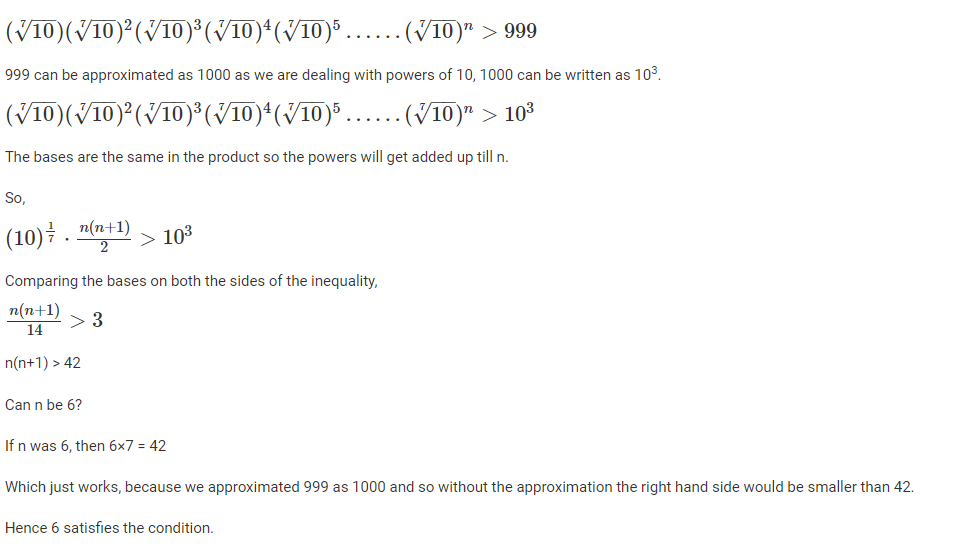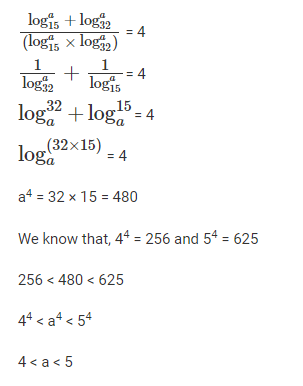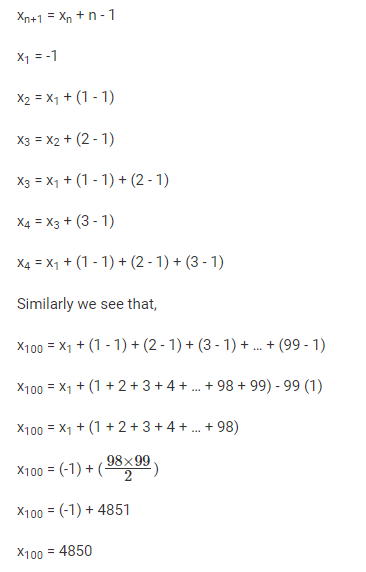Live Updates
• CATKing has launched new chat bot.

• New video on Logs has been released.
495
Learners
asked the doubt

Previous Year Questions
The passage below is accompanied by a set of questions. Choose the best answer to each question.
Today we can hardly conceive of ourselves without an unconscious. Yet between 1700 and 1900, this notion developed as a genuinely original thought. The "unconscious" burst the shell of conventional language, coined as it had been to embody the fleeting ideas and the shifting conceptions of several generations until, finally, it became fixed and defined in specialized terms within the realm of medical psychology and Freudian psychoanalysis.
The vocabulary concerning the soul and the mind increased enormously in the course of the nineteenth century. The enrichments of literary and intellectual language led to an altered understanding of the meanings that underlie time-honored expressions and traditional catchwords. At the same time, once coined, powerful new ideas attracted to themselves a whole host of seemingly unrelated issues, practices, and experiences, creating a peculiar network of preoccupations that as a group had not existed before. The drawn-out attempt to approach and define the unconscious brought together the spiritualist and the psychical researcher of borderline phenomena (such as apparitions, spectral illusions, haunted houses, mediums, trance, automatic writing); the psychiatrist or alienist probing the nature of mental disease, of abnormal ideation, hallucination, delirium, melancholia, mania; the surgeon performing operations with the aid of hypnotism; the magnetizer claiming to correct the disequilibrium in the universal flow of magnetic fluids but who soon came to be regarded as a clever manipulator of the imagination; the physiologist and the physician who puzzled over sleep, dreams, sleepwalking, anesthesia, the influence of the mind on the body in health and disease; the neurologist concerned with the functions of the brain and the physiological basis of mental life; the philosopher interested in the will, the emotions, consciousness, knowledge, imagination and the creative genius; and, last but not least, the psychologist.
Significantly, most if not all of these practices (for example, hypnotism in surgery or psychological magnetism) originated in the waning years of the eighteenth century and during the early decades of the nineteenth century, as did some of the disciplines (such as psychology and psychical research). The majority of topics too were either new or assumed hitherto unknown colors. Thus, before 1790, few if any spoke, in medical terms, of the affinity between creative genius and the hallucinations of the insane .
Striving vaguely and independently to give expression to a latent conception, various lines of thought can be brought together by some novel term. The new concept then serves as a kind of resting place or stocktaking in the development of ideas, giving satisfaction and a stimulus for further discussion or speculation. Thus, the massive introduction of the term unconscious by Hartmann in 1869 appeared to focalize many stray thoughts, affording a temporary feeling that a crucial step had been taken forward, a comprehensive knowledge gained, a knowledge that required only further elaboration, explication, and unfolding in order to bring in a bounty of higher understanding. Ultimately, Hartmann's attempt at defining the unconscious proved fruitless because he extended its reach into every realm of organic and inorganic, spiritual, intellectual, and instinctive existence, severely diluting the precision and compromising the impact of the concept.
Which one of the following sets of words is closest to mapping the main arguments of the passage?
Video Explanation

Explanatory Answer
The passage describes in detail how the introduction of the term unconscious by Hartmann in 1869 appeared to focalize various fleeting ideas and shifting conceptions over nearly two centuries, till it became fixed and defined within the realm of medical psychology and Freudian psychoanalysis. Option C touches upon all key aspects of the passage.
Options A, B and D are easily eliminated due to terms such as imagination, magnetism, dreams, literary language and insanity appearing in them. These do not represent the main arguments of the passage.
Which one of the following statements best describes what the passage is about?
Video Explanation

Explanatory Answer
The passage states in the first paragraph that the term unconscious 'burst the shell of conventional language, coined as it had been to embody the fleeting ideas and the shifting conceptions of several generations until, finally, it became fixed and defined in specialized terms within the realm of medical psychology and Freudian psychoanalysis.' It goes on to detail how various conceptions and ideas came together between 1700 and 1900, and how the 'massive introduction of the term unconscious by Hartmann in 1869 appeared to focalize many stray thoughts'. Option C sums up what the passage is about best.
"The enrichments of literary and intellectual language led to an altered understanding of the meanings that underlie time-honored expressions and traditional catchwords." Which one of the following interpretations of this sentence would be closest in meaning to the original?
Video Explanation

Explanatory Answer
The given sentence states that the enrichment- improvement/refinement- of literary and intellectual language changed the understanding of the meaning of time-honoured expressions and traditional catchwords. Option A is the correct interpretation.
All of the following statements may be considered valid inferences from the passage, EXCEPT:
Video Explanation

Explanatory Answer
Option A cannot be inferred from the passage. The passage does not mention anaesthesiology. It only says that with the introduction of the term 'unconscious', it seemed that this new knowledge could, with further elaboration and exploring, provide a bounty of higher understanding.
Option B can be inferred based on the various examples cited in the second paragraph of the passage.
The passage says that '...before 1790, few if any spoke, in medical terms, of the affinity between creative genius and the hallucinations of the insane...'. That is, eighteenth century thinkers were the first to perceive a connection between creative genius and insanity.
Option D states one of the key ideas of the passage: 'The vocabulary concerning the soul and the mind increased enormously in the course of the nineteenth century. The enrichments of literary and intellectual language led to an altered understanding of the meanings that underlie time-honored expressions and traditional catchwords. At the same time, once coined, powerful new ideas attracted to themselves a whole host of seemingly unrelated issues, practices, and experiences, creating a peculiar network of preoccupations that as a group had not existed before.'
The passage below is accompanied by a set of questions. Choose the best answer to each question.
Keeping time accurately comes with a price. The maximum accuracy of a clock is directly related to how much disorder, or entropy, it creates every time it ticks. Natalia Ares at the University of Oxford and her colleagues made this discovery using a tiny clock with an accuracy that can be controlled. The clock consists of a 50-nanometre-thick membrane of silicon nitride, vibrated by an electric current. Each time the membrane moved up and down once and then returned to its original position, the researchers counted a tick, and the regularity of the spacing between the ticks represented the accuracy of the clock. The researchers found that as they increased the clock's accuracy, the heat produced in the system grew, increasing the entropy of its surroundings by jostling nearby particles . . . "If a clock is more accurate, you are paying for it somehow," says Ares. In this case, you pay for it by pouring more ordered energy into the clock, which is then converted into entropy. "By measuring time, we are increasing the entropy of the universe," says Ares. The more entropy there is in the universe, the closer it may be to its eventual demise. "Maybe we should stop measuring time," says Ares. The scale of the additional entropy is so small, though, that there is no need to worry about its effects, she says.
The increase in entropy in timekeeping may be related to the "arrow of time", says Marcus Huber at the Austrian Academy of Sciences in Vienna, who was part of the research team. It has been suggested that the reason that time only flows forward, not in reverse, is that the total amount of entropy in the universe is constantly increasing, creating disorder that cannot be put in order again.
The relationship that the researchers found is a limit on the accuracy of a clock, so it doesn't mean that a clock that creates the most possible entropy would be maximally accurate - hence a large, inefficient grandfather clock isn't more precise than an atomic clock. "It's a bit like fuel use in a car. Just because I'm using more fuel doesn't mean that I'm going faster or further," says Huber.
When the researchers compared their results with theoretical models developed for clocks that rely on quantum effects, they were surprised to find that the relationship between accuracy and entropy seemed to be the same for both. . . . We can't be sure yet that these results are actually universal, though, because there are many types of clocks for which the relationship between accuracy and entropy haven't been tested. "It's still unclear how this principle plays out in real devices such as atomic clocks, which push the ultimate quantum limits of accuracy," says Mark Mitchison at Trinity College Dublin in Ireland. Understanding this relationship could be helpful for designing clocks in the future, particularly those used in quantum computers and other devices where both accuracy and temperature are crucial, says Ares. This finding could also help us understand more generally how the quantum world and the classical world are similar and different in terms of thermodynamics and the passage of time.
"It's a bit like fuel use in a car. Just because I'm using more fuel doesn't mean that I'm going faster or further . . ." What is the purpose of this example?
Video Explanation

Explanatory Answer
Note what the passage says before citing the example of fuel usage in a car: 'The relationship that the researchers found is a limit on the accuracy of a clock, so it doesn't mean that a clock that creates the most possible entropy would be maximally accurate'. Just as increased fuel usage in a car does not imply that it is going faster or farther, increased entropy does not mean increased accuracy.
The author makes all of the following arguments in the passage, EXCEPT that:
Video Explanation

Explanatory Answer
The official answer key says option B but we believe the right option is C.
The author does not say there is no difference in accuracy between a grandfather clock and an atomic clock. In fact he clearly states the opposite: '...a large, inefficient grandfather clock isn't more precise than an atomic clock.' So, option C is not an argument made in the passage.
On the other hand, option B is an argument the author makes in the first paragraph: '..the researchers found that as they increased the clock's accuracy, the heat produced in the system grew, increasing the entropy of its surroundings by jostling nearby particles . . . "If a clock is more accurate, you are paying for it somehow," says Ares.'
Options A and D are easily verified to be true, based on the lines 'The relationship that the researchers found is a limit on the accuracy of a clock, so it doesn't mean that a clock that creates the most possible entropy would be maximally accurate', and 'Understanding this relationship could be helpful for designing clocks in the future, particularly those used in quantum computers and other devices where both accuracy and temperature are crucial...'.
Which one of the following sets of words and phrases serves best as keywords of the passage?
Video Explanation

Explanatory Answer
'Measuring time', 'accuracy' and 'entropy' are key ideas in the passage. None of the given options but C mentions 'measuring time', which is what the passage is about.
None of the following statements can be inferred from the passage EXCEPT that:
Video Explanation

Explanatory Answer
'None of the following statements can be inferred except...' implies only one of the given statements can be inferred. According to the passage, 'Keeping time accurately comes with a price. The maximum accuracy of a clock is directly related to how much disorder, or entropy, it creates every time it ticks.' Since quantum computers are, according to the passage, 'devices where both accuracy and temperature are crucial', it can be inferred that quantum computers are likely to produce more heat and, hence, more entropy, because of the emphasis on accuracy. So, option B is the correct answer choice.
The passage only states that the 'arrow of time' may be related to increase in entropy in time keeping. Whether or not the arrow of time has been tested for atomic clocks cannot be inferred based on the information given in the passage.
According to the passage, higher accuracy in timekeeping leads to more heat and more entropy. The converse, however, is not necessarily true. So, option C, too, cannot be inferred.
In the experiment, the clock with a 50-nanometre-thick membrane of silicon nitride has been made to vibrate, using (not producing) electric currents. So, option D is incorrect.
The passage below is accompanied by a set of questions. Choose the best answer to each question.
Starting in 1957, [Noam Chomsky] proclaimed a new doctrine: Language, that most human of all attributes, was innate. The grammatical faculty was built into the infant brain, and your average 3-year-old was not a mere apprentice in the great enterprise of absorbing English from his or her parents, but a "linguistic genius." Since this message was couched in terms of Chomskyan theoretical linguistics, in discourse so opaque that it was nearly incomprehensible even to some scholars, many people did not hear it. Now, in a brilliant, witty and altogether satisfying book, Mr. Chomsky's colleague Steven Pinker . . . has brought Mr. Chomsky's findings to everyman. In "The Language Instinct" he has gathered persuasive data from such diverse fields as cognitive neuroscience, developmental psychology and speech therapy to make his points, and when he disagrees with Mr. Chomsky he tells you so. . . .
For Mr. Chomsky and Mr. Pinker, somewhere in the human brain there is a complex set of neural circuits that have been programmed with "super-rules" (making up what Mr. Chomsky calls "universal grammar"), and that these rules are unconscious and instinctive. A half-century ago, this would have been pooh-poohed as a "black box" theory, since one could not actually pinpoint this grammatical faculty in a specific part of the brain, or describe its functioning. But now things are different. Neurosurgeons [have now found that this] "black box" is situated in and around Broca's area, on the left side of the forebrain. . . .
Unlike Mr. Chomsky, Mr. Pinker firmly places the wiring of the brain for language within the framework of Darwinian natural selection and evolution. He effectively disposes of all claims that intelligent nonhuman primates like chimps have any abilities to learn and use language. It is not that chimps lack the vocal apparatus to speak; it is just that their brains are unable to produce or use grammar. On the other hand, the "language instinct," when it first appeared among our most distant hominid ancestors, must have given them a selective reproductive advantage over their competitors (including the ancestral chimps). . . .
So according to Mr. Pinker, the roots of language must be in the genes, but there cannot be a "grammar gene" any more than there can be a gene for the heart or any other complex body structure. This proposition will undoubtedly raise the hackles of some behavioral psychologists and anthropologists, for it apparently contradicts the liberal idea that human behavior may be changed for the better by improvements in culture and environment, and it might seem to invite the twin bugaboos of biological determinism and racism. Yet Mr. Pinker stresses one point that should allay such fears. Even though there are 4,000 to 6,000 languages today, they are all sufficiently alike to be considered one language by an extraterrestrial observer. In other words, most of the diversity of the world's cultures, so beloved to anthropologists, is superficial and minor compared to the similarities. Racial differences are literally only "skin deep." The fundamental unity of humanity is the theme of Mr. Chomsky's universal grammar, and of this exciting book.
Which one of the following statements best summarises the author's position about Pinker's book?
Video Explanation

Explanatory Answer
The author calls Pinker's book 'brilliant, witty and altogether satisfying'. In response to the claim that the book is racist, the author states that Pinkers stresses on the 'fundamental unity of humanity' and 'the universal grammar' of language- the universality of 'the language instinct', in other words, to counter such claims. So, option B is the right choice.
Option C is the exact opposite of the author's position.
According to the passage, Pinker argues that though chimps have the vocal apparatus to speak, their brains, unlike human brains, are unable to produce grammar as chimps do not have the 'language instinct'. The author agrees with Pinker's view, so option A is incorrect.
Again, option D is also incorrect, based on the last paragraph. The author says that while some behavioral psychologists and anthropologists believe human behavior may be changed for the better by improvements in culture and environment, Pinker's position (one that the author agrees with) is that the roots of language are in the genes.
According to the passage, all of the following are true about the language instinct EXCEPT that:
Video Explanation

Explanatory Answer
The question asks us to pick an option which is not true.
According to the passage, Pinker 'effectively disposes of all claims that intelligent nonhuman primates like chimps have any abilities to learn and use language.' So, option A is not true (and hence the correct answer choice).
Option B is the exact opposite of A, and clearly true, as seen above.
According to the passage, a half-century ago, Chomsky/Pinker's idea of universal grammar 'would have been pooh-poohed as a "black box" theory' but 'neurosurgeons [have now found that this] "black box" is situated in and around Broca's area, on the left side of the forebrain'. So, option C is true.
The passage states that, according to Pinker, '....the "language instinct," when it first appeared among our most distant hominid ancestors, must have given them a selective reproductive advantage over their competitors (including the ancestral chimps)'. So, option D is also true.
From the passage, it can be inferred that all of the following are true about Pinker's book, "The Language Instinct", EXCEPT that Pinker:
Video Explanation

Explanatory Answer
In the last paragraph, the passage states that Pinker's proposition that the roots of language must be in the genes will 'undoubtedly raise the hackles of some behavioral psychologists and anthropologists, for it apparently contradicts the liberal idea that human behavior may be changed for the better by improvements in culture and environment'. So, Pinker's position is at variance with that of behavioural psychologists. Option D is not true about Pinker's book.
According to the passage, while Chomsky's book was full of 'theoretical linguistics, in discourse so opaque that it was nearly incomprehensible even to some scholars', Pinker's book is 'brilliant, witty and altogether satisfying'. So, option A is true.
That Pinker disagrees with Chomsky on some grounds is mentioned in the last line of the first paragraph, as well as in the third paragraph, where the passage states that 'Unlike Mr. Chomsky, Mr. Pinker firmly places the wiring of the brain for language within the framework of Darwinian natural selection and evolution'. So, option B is true.
Pinker's book, according to the passage, 'has brought Mr. Chomsky's findings to everyman'. So, option C is also true.
On the basis of the information in the passage, Pinker and Chomsky may disagree with each other on which one of the following points?
Video Explanation

Explanatory Answer
Note the line: 'Unlike Mr. Chomsky, Mr. Pinker firmly places the wiring of the brain for language within the framework of Darwinian natural selection and evolution.' So, Pinker and Chomsky may disagree on the Darwinian explanatory paradigm for language.
The passage below is accompanied by a set of questions. Choose the best answer to each question.
Back in the early 2000s, an awesome thing happened in the New X-Men comics. Our mutant heroes had been battling giant robots called Sentinels for years, but suddenly these mechanical overlords spawned a new threat: Nano-Sentinels! Not content to rule Earth with their metal fists, these tiny robots invaded our bodies at the microscopic level. Infected humans were slowly converted into machines, cell by cell.
Now, a new wave of extremely odd robots is making at least part of the Nano-Sentinels story come true. Using exotic fabrication materials like squishy hydrogels and elastic polymers, researchers are making autonomous devices that are often tiny and that could turn out to be more powerful than an army of Terminators. Some are 1-centimetre blobs that can skate over water. Others are flat sheets that can roll themselves into tubes, or matchstick-sized plastic coils that act as powerful muscles. No, they won't be invading our bodies and turning us into Sentinels - which I personally find a little disappointing - but some of them could one day swim through our bloodstream to heal us. They could also clean up pollutants in water or fold themselves into different kinds of vehicles for us to drive. . . .
Unlike a traditional robot, which is made of mechanical parts, these new kinds of robots are made from molecular parts. The principle is the same: both are devices that can move around and do things independently. But a robot made from smart materials might be nothing more than a pink drop of hydrogel. Instead of gears and wires, it's assembled from two kinds of molecules - some that love water and some that avoid it - which interact to allow the bot to skate on top of a pond.
Sometimes these materials are used to enhance more conventional robots. One team of researchers, for example, has developed a different kind of hydrogel that becomes sticky when exposed to a low-voltage zap of electricity and then stops being sticky when the electricity is switched off. This putty-like gel can be pasted right onto the feet or wheels of a robot. When the robot wants to climb a sheer wall or scoot across the ceiling, it can activate its sticky feet with a few volts. Once it is back on a flat surface again, the robot turns off the adhesive like a light switch.
Robots that are wholly or partly made of gloop aren't the future that I was promised in science fiction. But it's definitely the future I want. I'm especially keen on the nanometre-scale "soft robots" that could one day swim through our bodies. Metin Sitti, a director at the Max Planck Institute for Intelligent Systems in Germany, worked with colleagues to prototype these tiny, synthetic beasts using various stretchy materials, such as simple rubber, and seeding them with magnetic microparticles. They are assembled into a finished shape by applying magnetic fields. The results look like flowers or geometric shapes made from Tinkertoy ball and stick modelling kits. They're guided through tubes of fluid using magnets, and can even stop and cling to the sides of a tube.
Which one of the following statements best summarises the central point of the passage?
Video Explanation

Explanatory Answer
The central idea of the passage is that nano-robots, which were once part of science fiction and comics, have now come true, with scientific researchers making such autonomous devices from molecular parts. Option A is the correct choice.
Options B and D state some ideas from the passage, but not the central idea.
Which one of the following statements best captures the sense of the first paragraph?
Video Explanation

Explanatory Answer
About the New X-Men, the first paragraph says that 'Our mutant heroes had been battling giant robots called Sentinels for years, but suddenly these mechanical overlords spawned a new threat: Nano-Sentinels!' So, option D is true
Which one of the following scenarios, if false, could be seen as supporting the passage?
Video Explanation

Explanatory Answer
Trickily worded question. The scenario which if false, supports the passage is one that if true, is against the passage.
Of Nano-Sentinels, the passage states that 'No, they won't be invading our bodies and turning us into Sentinels'. That is, these Nano-Sentinel robots do not turn the body they are injected into to robots. So, option A, if true, goes against the passage. Hence, this is the correct answer choice.
The passage states that Nano-sentinels are ' assembled from two kinds of molecules - some that love water and some that avoid it'. So, option B is in line with the passage.
That robots made from smart materials are likely to become part of our everyday lives in the future is the central idea of the passage. So, C is also in line with the passage.
In the fourth paragraph, the passage discusses hydrogels and their applications. So, D is also in line with the passage.
Which one of the following statements, if true, would be the most direct extension of the arguments in the passage?
Video Explanation

Explanatory Answer
Option A is the direct extension of 'some of them could one day swim through our bloodstream to heal us. They could also clean up pollutants in water or fold themselves into different kinds of vehicles for us to drive.'
The four sentences (labelled 1, 2, 3 and 4) below, when properly sequenced would yield a coherent paragraph. Decide on the proper sequencing of the order of the sentences and key in the sequence of the four numbers as your answer:
1. Businesses find automation, such as robotic employees, a big asset in terms of productivity and efficiency.
2. But in recent years, robotics has had increasing impacts on unemployment, not just of manual labour, as computers are rapidly handling some white-collar and service-sector work.
3. For years politicians have promised workers that they would bring back their jobs by clamping down on trade, offshoring and immigration.
4. Economists, based on their research, say that the bigger threat to jobs now is not globalisation but automation.
Video Explanation

Explanatory Answer
Sentence 3 is the best opening sentence. 34 is a unit: 3 identifies trade, offshoring and immigration as threats to jobs, while 4 states that the bigger threat now is automation. 1 continues the idea in 4, stating the value that businesses find in automation. 2 adds to 1 and concludes the paragraph, elaborating on the impact of robotics on unemployment. 3412 is a cogent paragraph.
Five jumbled up sentences, related to a topic, are given below. Four of them can be put together to form a coherent paragraph. Identify the odd one out and key in the number of the sentence as your answer:
1. They often include a foundation course on navigating capitalism with Chinese characteristics and have replaced typical cases from US corporates with a focus on how Western theories apply to China's buzzing local firms.
2. The best Chinese business schools look like their Western rivals but are now growing distinct in terms of what they teach and the career boost they offer.
3. Western schools have enhanced their offerings with double degrees, popular with domestic and overseas students alike-and boosted the prestige of their Chinese partners.
4. For students, a big draw is the chance to rub shoulders with captains of China's private sector.
5. Their business courses now largely cater to the growing demand from China Inc which has become more global, richer and ready to recruit from this sinocentric student body.
Video Explanation

Explanatory Answer
While all other sentences relate to Chinese business schools and the courses they offer, sentence 3 relates to Western schools and their offerings. So, 3 is the odd one out.
2514 makes a cogent paragraph, with 2 opening the paragraph stating how Chinese schools are growing distinct from their Western counterparts, 5 and 1 adding to 2 in terms of the courses offered and 4 concluding the paragraph with the additional incentive that these schools provide Chinese students.
The four sentences (labelled 1, 2, 3, 4) below, when properly sequenced would yield a coherent paragraph. Decide on the proper sequencing of the order of the sentences and key in the sequence of the four numbers as your answer:
1. It is regimes of truth that make certain relationships speakable - relationships, like subjectivities, are constituted through discursive formations, which sustain regimes of truth.
2. Relationships are nothing without the communication that brings them into being; interpersonal communication is connected to knowledge shared by interlocutors, and scholars should attend to relational histories in their analyses.
3. A Foucauldian approach to relationships goes beyond these conceptions of discourse and history to macrolevel regimes of truth as constituting relationships.
4. Reconsidering micropractices within relationships that are constituted within and simultaneously contributors to regimes of truth acknowledges the central position of power/knowledge in the constitution of what has come to be considered true and real.
Video Explanation

Explanatory Answer
Sentence 2 offers the best start to the paragraph and talks about the importance of relational histories in the analysis of interpersonal communication. Sentences 1, 3 and 4 relate to the idea of 'regimes of truth', which is first introduced in 3, which talks about a Foucaldian approach going beyond the existing conceptions of discourse and history. So, 3 follows 2. Sentence 1 expands on 'regimes of truth' and how they make relationships speakable and sustain them. Sentence 4 adds to 1 and concludes the paragraph.
The four sentences (labelled 1, 2, 3 and 4) below, when properly sequenced would yield a coherent paragraph. Decide on the proper sequencing of the order of the sentences and key in the sequence of the four numbers as your answer:
1. Restitution of artefacts to original cultures could faces legal obstacles, as many Western museums are legally prohibited from disposing off their collections.
2. This is in response to countries like Nigeria, which are pressurising European museums to return their precious artefacts looted by colonisers in the past.
3. Museums in Europe today are struggling to come to terms with their colonial legacy, some taking steps to return artefacts but not wanting to lose their prized collections.
4. Legal hurdles notwithstanding, politicians and institutions in France and Germany would now like to defuse the colonial time bombs, and are now backing the return of part of their holdings.
Video Explanation

Explanatory Answer
Sentence 3 is the best opening sentence. Sentence 3 talks about some European museums taking steps to return artefacts; 2 states what these steps are in response to. So, we have the order 32. 14 is a unit, with 1 talking about the legal hurdles in the restitution of artefacts and 4 following this up with what some countries would like to do, legal hurdles notwithstanding. So, 3214 is the correct order.
Five jumbled up sentences, related to a topic, are given below. Four of them can be put together to form a coherent paragraph. Identify the odd one out and key in the number of the sentence as your answer:
1. A typical example is Wikipedia, where the overwhelming majority of contributors are male and so the available content is skewed to reflect their interests.
2. Without diversity of thought and representation, society is left with a distorted picture of future options, which are likely to result in augmenting existing inequalities.
3. Gross gender inequality in the technology sector is problematic, not only for the industry-wide marginalisation of women, but because technology designs embody the values of their makers.
4. While redressing unequal representation in the workplace is a step in the right direction, broader social change is needed to address the structural inequalities embedded within the current organisation of work and employment.
5. If technology merely reflects the perspectives of the male stereotype, then new technologies are unlikely to accommodate the diverse social contexts within which they operate.
Video Explanation

Explanatory Answer
While all other sentences are about gender inequality in the technology sector and its impact on society, sentence 4 is more general, about structural inequalities in the current organisation of work and employment.
3512 makes a cogent paragraph, with 3 stating the main idea of the paragraph, 5 adding on to 3, 1 citing an example to support 5 and 2 concluding the paragraph.
The passage given below is followed by four alternate summaries. Choose the option that best captures the essence of the passage.
People view idleness as a sin and industriousness as a virtue, and in the process have developed an unsatisfactory relationship with their jobs. Work has become a way for them to keep busy, even though many find their work meaningless. In their need for activity people undertake what was once considered work (fishing, gardening) as hobbies. The opposing view is that hard work has made us prosperous and improved our levels of health and education. It has also brought innovation and labour and time-saving devices, which have lessened life's drudgery.
Video Explanation

Explanatory Answer
The paragraph given presents two opposing views on hard work. In one view, hard work has led to meaningless jobs as people strive to keep busy at all costs, while in the opposing view, hard work has brought about innovation and comfort. Option D sums up the paragraph well.
Option A is incorrect, as it states that hard work has 'led to greater idleness'. The paragraph does not say so.
Option B presents a one-sided view and is hence incorrect.
The paragraph does not talk about the importance of leisure time. So, option C is also incorrect.
The passage given below is followed by four alternate summaries. Choose the option that best captures the essence of the passage.
Brazil's growth rate has been low, yet most Brazilians say their financial situation has improved, and they expect it to get even better. This is because most incomes are rising fast, with higher minimum wages and very low unemployment. The result is falling inequality and a growing middle class - the result of economic stabilization, improved social security and universal primary education. But despite recent improvements the Brazilian economy is still painfully unequal, with poor Brazilians paying the biggest share of their income in taxes and getting the least back in government services.
Video Explanation

Explanatory Answer
This paragraph states that while Brazilians have seen inequality falling and their financial situation improving due to economic stabilisation, the economy remains very unequal and the poor end up paying the biggest share of taxes despite getting the least services back from the government. Option A touches upon all key points and sums up the paragraph well.
Options B and C do not talk about the unfair taxation of the poor. So, they can be eliminated.
Option D states that the Brazilian economy is likely to be destabilised in the next few years. The paragraph makes no such prediction.
The passage given below is followed by four alternate summaries. Choose the option that best captures the essence of the passage.
The human mind is wired to see patterns. Not only does the brain process information as it comes in, it also stores insights from all our past experiences. Every interaction, happy or sad, is catalogued in our memory. Intuition draws from that deep memory well to inform our decisions going forward. In other words, intuitive decisions are based on data, and not contrary to data as many would like to assume. When we subconsciously spot patterns, the body starts firing neurochemicals in both the brain and gut. These "somatic markers" are what give us that instant sense that something is right ... or that it's off. Not only are these automatic processes faster than rational thought, but our intuition draws from decades of diverse qualitative experience (sights, sounds, interactions, etc.) - a wholly human feature that big data alone could never accomplish.
Video Explanation

Explanatory Answer
This paragraph explains how intuition works: the human mind draws upon a 'deep memory well' based on decades of diverse qualitative experience to subconsciously spot patterns and fire neurochemicals in the brain and gut. Of the given options, D sums up the paragraph best.
Option A states that decisions based on intuitions are 'better'. The paragraph does not say so.
Option B is incorrect as it says intuitions 'may not be related to data'. This is the opposite of what the paragraph states.
Option C implies big data is based on rational thought while intuition is not. This is incorrect.
The cost of fencing a rectangular plot is ₹ 200 per ft along one side, and ₹ 100 per ft along the three other sides. If the area of the rectangular plot is 60000 sq. ft, then the lowest possible cost of fencing all four sides, in INR, is
Video Explanation

Explanatory Answer

Let the length be x and the breadth be y,
Then the area of the region will be
x×y = 60000
Then the cost of fencing the region will be
200x + 100x + 100y + 100y
300x + 200y
Now we know that the Arithmetic mean ≥ Geometric mean.
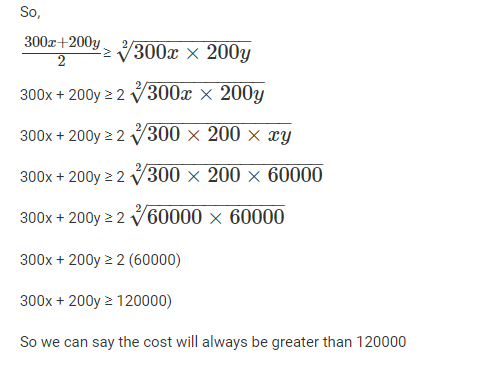
The total of male and female populations in a city increased by 25% from 1970 to 1980. During the same period, the male population increased by 40% while the female population increased by 20%. From 1980 to 1990, the female population increased by 25%. In 1990, if the female population is twice the male population, then the percentage increase in the total of male and female populations in the city from 1970 to 1990 is
Video Explanation

Explanatory Answer
From 1970 to 1980,
the male population increased by 40%
the female population increased by 20%
the overall population increased by 25%
1.4M + 1.2F = 1.25(M + F)
1.4M + 1.2F = 1.25M + 1.25F
1.4M - 1.25M = 1.25F - 1.2F
0.15M = 0.05F
F = 3M
From 1980 to 1990,
Female population increased by 25%
Therefore, the female population in 1990 = 1.25 × 1.2F = 1.5F
Since, the female population in 1990 is twice the male population,
Male population in 1990 = 1.5F ÷ 2 = 0.75F
Since F = 3M,
Male population in 1990 = 2.25M
Total population in 1970 = M + F = M + 3M = 4M
Total population in 1990 = 2.25M + 1.5F = 2.25M + 4.5M = 6.75M

Mira and Amal walk along a circular track, starting from the same point at the same time. If they walk in the same direction, then in 45 minutes, Amal completes exactly 3 more rounds than Mira. If they walk in opposite directions, then they meet for the first time exactly after 3 minutes. The number of rounds Mira walks in one hour is
Video Explanation

Explanatory Answer
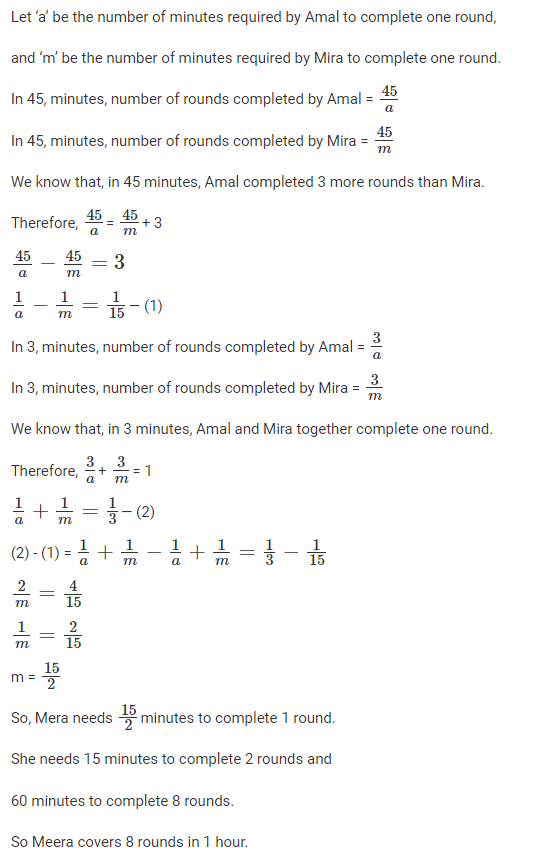
In a tournament, a team has played 40 matches so far and won 30% of them. If they win 60% of the remaining matches, their overall win percentage will be 50%. Suppose they win 90% of the remaining matches, then the total number of matches won by the team in the tournament will be
Video Explanation

Explanatory Answer
Let the number of matches to be played be ‘x’
We are given that 40 matches are already played and 30% of them are won.
If 60% of the remaining matches are won, then the overall win percentage is 50%.
30% of 40 + 60% of x = 50% of (40 + x)
0.3 (40) + 0.6 (x) = 0.5 (40 + x)
12 + 0.6 (x) = 20 + 0.5 (x)
0.1 (x) = 8
x = 80
The number of matches to be played is 80.
If the team wins 90% of the remaining matches, it would win 90% of 80 = 72 matches.
Total matches won by the team
= 30% of 40 + 72
= 12 + 72 = 84
If 3x + 2|y| + y = 7 and x + |x| + 3y = 1, then x + 2y is
Video Explanation

Explanatory Answer
3x + 2|y| + y = 7
x + |x| + 3y = 1
lets take x and y to be positive
3x+3y=7
2x+3y=1
x=6, but y is negative so this case is invalid
Lets take x is +ve and y is -ve
3x-y=7
2x+3y=1
à x=2 and y=-1
Case is valid
x+2y = 2 + 2(-1) = 0
One part of a hostel's monthly expenses is fixed, and the other part is proportional to the number of its boarders. The hostel collects ₹ 1600 per month from each boarder. When the number of boarders is 50, the profit of the hostel is ₹ 200 per boarder, and when the number of boarders is 75, the profit of the hostel is ₹ 250 per boarder. When the number of boarders is 80, the total profit of the hostel, in INR, will be
Video Explanation

Explanatory Answer
Let the fixed cost be ₹ F and the variable cost be ₹ V.
Since the profit per border is ₹200 when there are 50 borders
The expenses of the Hostel is,
F + 50(V) = 50 (1600 - 200)
F + 50(V) = 50 (1400) — (1)
Since the profit per border is ₹250 when there are 75 borders
The expenses of the Hostel is,
F + 75(V) = 75 (1600 - 250)
F + 75(V) = 75 (1350) — (2)
(2) - (1)
25(V) = 75(1350) - 50(1400)
25(V) = 25( 3(1350) - 2(1400) )
V = 3(1350) - 2(1400)
V = 4050 - 2800
V = 1250
F + 75(V) = 75 (1350)
F + 75(1250) = 75 (1350)
F = 75(100) = 7500
The Expenditure for 80 borders will be,
= F + 80(V)
= 7500 + 80(1250)
The revenue collected from 80 students is,
= 80(1600)
Hence, the profit is,
= 80(1600) - (7500 + 80(1250))
= 80(1600 - 1250) - 7500
= 80(350) - 7500
= 100(8×35 - 75)
= 20500
Hence the total profit when there are 80 borders is ₹20500.
A shop owner bought a total of 64 shirts from a wholesale market that came in two sizes, small and large. The price of a small shirt was INR 50 less than that of a large shirt. She paid a total of INR 5000 for the large shirts, and a total of INR 1800 for the small shirts. Then, the price of a large shirt and a small shirt together, in INR, is
Video Explanation

Explanatory Answer
Let the number of small shirts be ‘x’
then the number of large shirts becomes 64 - x.
Let the price of a small shirt be ‘y’
then the price of a large shirt becomes y + 50
Money spent on small shirts = xy = 1800
Money spent on large shirts = (64 - x) (y + 50) = 5000
(64 - x) (y + 50) = 5000
64y + 3200 - xy - 50x = 5000
64y + 3200 - 1800 - 50x = 5000
64y + 1400 - 50x = 5000
64y - 50x = 3600
32y - 25x = 1800
32y - 25(1800/y) = 1800
32y2 - 1800y - 25(1800) = 0
4y2 - 9(25)y - 25(9)(25) = 0
y = 75
Price of a small shirt = ‘y’ = 75
Price of a small shirt = ‘y + 50’ = 125
The price of a large shirt and a small shirt together, in INR = 75 + 125 = 200
The arithmetic mean of scores of 25 students in an examination is 50. Five of these students top the examination with the same score. If the scores of the other students are distinct integers with the lowest being 30, then the maximum possible score of the toppers is
Video Explanation

Explanatory Answer
he arithmetic mean of the scores of 25 students = 50
Sum of scores of these students = 25 × 50 = 1250
For the scores of the top 5 students to be as high as possible, the score of the bottom 20 students should be as low as possible.
The minimum score is 30, and the scores of the bottom 20 students are distinct integers.
In order for the bottom 20 scores to be as low as possible, they must be,
30, 31, 32, … 49
Sum of the bottom 20 scores
= 30 + 31 + 32 + … + 49
= (30 + 0) + (30 + 1) + (30 + 2) + … + (30 + 19)
= 20 × 30 + (0 + 1 + 2 + 3 + … + 19)
= 600 + ![]()
Bank A offers 6% interest rate per annum compounded half yearly. Bank B and Bank C offer simple interest but the annual interest rate offered by Bank C is twice that of Bank B. Raju invests a certain amount in Bank B for a certain period and Rupa invests ₹ 10,000 in Bank C for twice that period. The interest that would accrue to Raju during that period is equal to the interest that would have accrued had he invested the same amount in Bank A for one year. The interest accrued, in INR, to Rupa is
Video Explanation

Explanatory Answer
Bank A has a rate of interest of 6% and compounds half yearly.
This is the same as having a 3% interest rate per half-year.
So, if a Principal, P is invested for an year in bank A, at the end of the year it becomes P(1.03)(1.03) = P(1.0609)
Therefore the interest rate when viewed as a Simple interest scheme is 6.09% per annum.
Rupa invested in Bank C, which has twice the interest rate as Bank B and the quantum for which the investment is made is also double, hence Rupa effectively gets 4 times the interest that Raju gets for the same investment in Bank A.
Let’s say Raju invested ₹ 10,000 in Bank B.
Since this is the same as investing in Bank A for 1 year, his interest would be 6.09% of 10,000 = ₹ 609.
Now, for the same investment, Rupa must earn 4 times that of ₹ 609
So, Rupa earns ₹ 2,436

Video Explanation

Explanatory Answer
g(x) = x + 3
f(x) = x2 - 7x
f(g(x)) - 3x
= f(x + 3) - 3x
= (x + 3)2 - 7(x + 3) - 3x
= x2 + 9 + 6x - 7x - 21 - 3x
= x2 - 4x - 12
= x2 - 4x + 4 - 4 - 12
= x2 - 4x + 4 - 16
= (x - 2)2 - 16
f(g(x)) - 3x is minimum when (x - 2)2 - 16 is minimum.
(x - 2)2 - 16 is minimum when (x - 2)2 is minimum.
Since (x - 2)2 is non-negative, the minimum value it can take is 0.
Hence the minimum value of (x - 2)2 - 16 = 0 - 16 = -16
Therefore, the minimum value of f(g(x)) - 3x is -16
If a certain weight of an alloy of silver and copper is mixed with 3 kg of pure silver, the resulting alloy will have 90% silver by weight. If the same weight of the initial alloy is mixed with 2 kg of another alloy which has 90% silver by weight, the resulting alloy will have 84% silver by weight. Then, the weight of the initial alloy, in kg, is
Video Explanation

Explanatory Answer
Let the weight of Silver in the initial Alloy be Ag kgs
and the weight of Copper in the initial Alloy be Cu kgs
So, the total weight of the initial Alloy = (Ag + Cu) kgs
This Alloy is mixed with 3kgs of Pure Silver to form a new mixture.
Total weight of the mixture = (Ag + Cu) + 3 kgs
Weight of Silver in the mixture = (Ag + 3) kgs
Since this mixture contains 90% Silver,
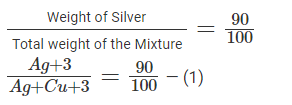
The initial Alloy is mixed with 2kgs of another alloy having 90% Silver by weight.
Total weight of the mixture = (Ag + Cu) + 2 kgs
Weight of Silver in the mixture = (Ag + 90% of 2) kgs = (Ag + 1.8) kgs
Since this mixture contains 84% Silver,
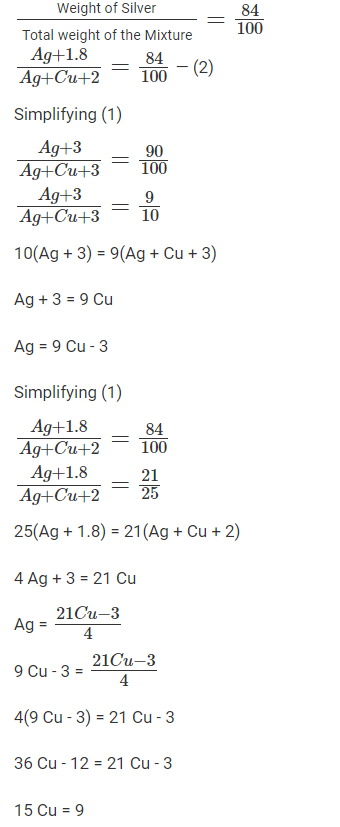

One day, Rahul started a work at 9 AM and Gautam joined him two hours later. They then worked together and completed the work at 5 PM the same day. If both had started at 9 AM and worked together, the work would have been completed 30 minutes earlier. Working alone, the time Rahul would have taken, in hours, to complete the work is
Video Explanation

Explanatory Answer
Let R be the fraction of work done by Rahul in 1 hour.
and G be the fraction of work done by Gautam in 1 hour.
Initially Rahul works from 9AM to 5PM (8 hours) and Gautam works for 2 hours less.
8R + 6G = 1 whole unit of work
If they start together they finish 30 minutes earlier or if they start at 9 AM, they finish at 4:30PM (7.5 hours)
7.5R + 7.5G = 1 whole unit of work
8R + 6G = 7.5R + 7.5G
0.5R = 1.5G
R = 3G
This means Rahul is thrice as efficient as Gautam.
8R + 6G = 1 whole unit of work
8R + 2R = 1 whole unit of work
10R = 1 whole unit of work
R is the fraction of work done by Rahul in 1 hour.
Since 10R = 1
R alone takes 10 hours to finish the job.
A tea shop offers tea in cups of three different sizes. The product of the prices, in INR, of three different sizes is equal to 800. The prices of the smallest size and the medium size are in the ratio 2 : 5. If the shop owner decides to increase the prices of the smallest and the medium ones by INR 6 keeping the price of the largest size unchanged, the product then changes to 3200. The sum of the original prices of three different sizes, in INR, is
Video Explanation

Explanatory Answer
Since the prices of the small and medium cups are in the ratio 2 : 5,
Let us assume the prices of the small, medium and large cups to be 2x, 5x and y.
We are given that the product of the three prices is 800.
Therefore, (2x)(5x)(y) = 800 —- (1)
If the price of the smallest and the medium cups are increased by 6, then the product becomes 3200
(2x + 6) (5x + 6) (y) = 3200 —- (2)

(2x + 6) (5x + 6) = 40 x2
10 x2 + 42x + 36 = 40 x2
30 x2 - 42x - 36 = 0
10 x2 - 14x - 12 = 0
10 x2 - 20x + 6x - 12 = 0
10 x(x - 2) + 6(x - 2) = 0
(10x + 6) (x - 2) = 0
x = 2 or x = -0.6
x can’t be negative and hence x = 2
WKT, (2x)(5x)(y) = 800
(4)(10)(y) = 800
y = 20
Therefore, the sum of the prices = 2x + 5x + y
= 2(2) + 5(2) + 20
= 4 + 10 + 20
= 34
A four-digit number is formed by using only the digits 1, 2 and 3 such that both 2 and 3 appear at least once. The number of all such four-digit numbers is
Video Explanation

Explanatory Answer
We will select the 4 digits first and arrange them later.
Out of the 4 digits, one of them should be 2 and one of them should be 3.
2, 3, , .
So, we just need to select the other two digits…
The two digits could be (1,1), (2, 2), (3, 3), (1, 2), (1, 3), or (2, 3).
So, the selection of numbers could be…
2, 3, 1, 1
2, 3, 2, 2
2, 3, 3, 3
2, 3, 1, 2
2, 3, 1, 3
2, 3, 2, 3
Each of these selections could be re-arranged in a number of ways.
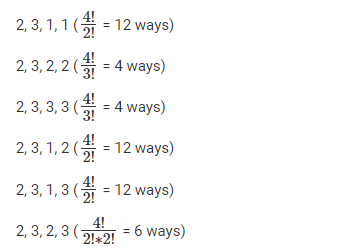
So total number of possibilities = (12 + 4 + 4 + 12 + 12 + 6) = 50 ways.
Alternate method:
(Arrangements with at least one 2 and one 3) = (All possible arrangements) - (Arrangements with either 1 or 2) - (Arrangements with either 1 or 3) + (Arrangements with only 1)
Think why we need to add (Arrangements with only 1)!
_, _, _, _
(All possible arrangements) = 34
Each blank could be any one of 1, 2 or 3.
(Arrangements with either 1 or 2) = 24
Each blank could be any one of 1 or 2.
(Arrangements with either 1 or 3) = 24
Each blank could be any one of 1 or 3.
(Arrangements with only 1) = 1
Each blank is filled with 1.
(Arrangements with at least one 2 and one 3) = (All possible arrangements) - (Arrangements with either 1 or 2) - (Arrangements with either 1 or 3) + (Arrangements with only 1)
(Arrangements with at least one 2 and one 3) = 34 - 24 - 24 + 1
(Arrangements with at least one 2 and one 3) = 81 - 16 - 16 + 1
(Arrangements with at least one 2 and one 3) = 82 - 32 = 50
In a triangle ABC, ∠ BCA = 50°. D and E are points on AB and AC, respectively, such that AD = DE. If F is a point on BC such that BD = DF, then ∠FDE, in degrees, is equal to
Video Explanation

Explanatory Answer
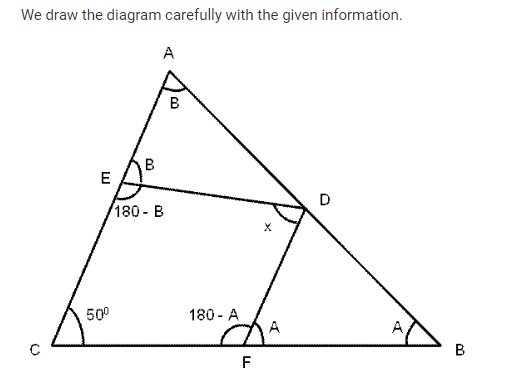
From the triangle ABC,
∠A + ∠B + ∠C = 1800
∠A + ∠B + 500 = 1800
∠A + ∠B = 1300
In the quadrilateral CFDE,
∠C + ∠F + ∠D + ∠E = 3600
500 + 1800 - ∠A + ∠x + 1800 - ∠B = 3600
500 + ∠x = ∠A + ∠B
500 + ∠x = 1300
∠x = 800
∠FDE = 800
Let ABCD be a parallelogram. The lengths of the side AD and the diagonal AC are 10 cm and 20 cm, respectively. If the angle ∠ADC is equal to 30° then the area of the parallelogram, in sq. cm, is
Video Explanation

Explanatory Answer
Revising the Cosine rule and the area of the triangle using the Sine rule…
We draw the described parallelogram ABCD.
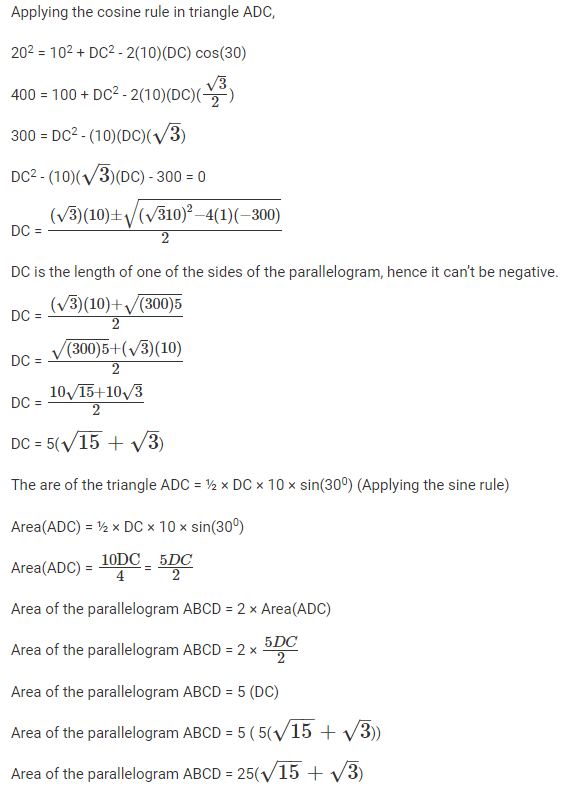
The number of distinct pairs of integers (m,n) satisfying |1+mn| < |m + n| < 5 is
Video Explanation

Explanatory Answer
|1 + mn| < |m + n| < 5
For two numbers ‘a’ and ‘b’,
|a| < |b| is equivalent to a2 < b2
So, we can say that:
(1 + mn)2 < (m + n)2
1 + 2mn +m2n2 < m2 + n2 + 2mn
1 - n2 - m2 + m2n2 < 0
(1 - n2) - m2(1 - n2) < 0
(1 - m2)(1 - n2) < 0
For the product to be negative, either one of the two terms has to be negative.
But they cannot simultaneously be 0.
The only possibility for either of the two terms to be positive is when
n = 0 and |m| > 1, or |n| > 1 and m = 0
Now for the case when m = 0 and |n| > 1
|m + n| < 5
|0 + n| < 5
So n can be ±±2, ±±3, ±±4
Which are 6 cases
Similarly for the case when n = 1 and |m| > 1
|m + n| < 5
|0 + m| < 5
So m can be ±±2, ±±3, ±±4
Again we have 6 cases.
Hence the answer is 12.
A park is shaped like a rhombus and has area 96 sq m. If 40 m of fencing is needed to enclose the park, the cost, in INR, of laying electric wires along its two diagonals, at the rate of ₹125 per m, is
Video Explanation

Explanatory Answer
The are of the rhombus is given by,
Area = ½ × d1 × d2
Where d1 & d2 are the diagonals of the rhombus.
Area = ½ × d1 × d2
96 = ½ × d1 × d2
96 × 4 = 2 × d1 × d2
Also,

d12 + d22 = 400
(d1 + d2 )2 = d12 + d22 + 2 × d1 × d2
(d1 + d2 )2 = 400 + 4(96)
(d1 + d2 )2 = 4(100 + 96)
(d1 + d2 )2 = 4(196)
(d1 + d2) = 2(14)
d1 + d2 = 28
The cost of laying electric wires along the diagonals at the rate of ₹125 per meter
= 28 × 125
= ₹3500
Anil can paint a house in 12 days while Barun can paint it in 16 days. Anil, Barun, and Chandu undertake to paint the house for ₹ 24000 and the three of them together complete the painting in 6 days. If Chandu is paid in proportion to the work done by him, then the amount in INR received by him is
Video Explanation

Explanatory Answer
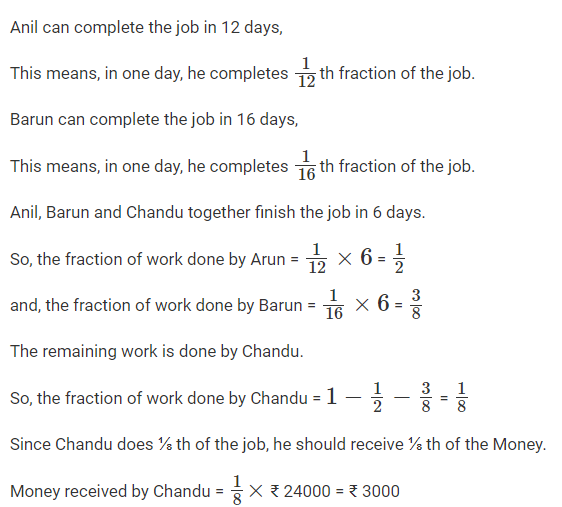
Three reviewers Amal, Bimal, and Komal are tasked with selecting questions from a pool of 13 questions (Q01 to Q13). Questions can be created by external "subject matter experts" (SMEs) or by one of the three reviewers. Each of the reviewers either approves or disapproves a question that is shown to them. Their decisions lead to eventual acceptance or rejection of the question in the manner described below.
If a question is created by an SME, it is reviewed first by Amal, and then by Bimal. If both of them approve the question, then the question is accepted and is not reviewed by Komal. If both disapprove the question, it is rejected and is not reviewed by Komal. If one of them approves the question and the other disapproves it, then the question is reviewed by Komal. Then the question is accepted only if she approves it.
A question created by one of the reviewers is decided upon by the other two. If a question is created by Amal, then it is first reviewed by Bimal. If Bimal approves the question, then it is accepted. Otherwise, it is reviewed by Komal. The question is then accepted only if Komal approves it. A similar process is followed for questions created by Bimal, whose questions are first reviewed by Komal, and then by Amal only if Komal disapproves it. Questions created by Komal are first reviewed by Amal, and then, if required, by Bimal.
The following facts are known about the review process after its completion.
1. Q02, Q06, Q09, Q11, and Q12 were rejected and the other questions were accepted.
2. Amal reviewed only Q02, Q03, Q04, Q06, Q08, Q10, Q11, and Q13.
3. Bimal reviewed only Q02, Q04, Q06 through Q09, Q12, and Q13.
4. Komal reviewed only Q01 through Q05, Q07, Q08, Q09, Q11, and Q12.
How many questions were DEFINITELY created by Komal?
Video Explanation

Explanatory Answer













How many questions were DEFINITELY created by the SMEs?
Video Explanation

Explanatory Answer













How many questions were DEFINITELY disapproved by Bimal?
Video Explanation

Explanatory Answer














The approval ratio of a reviewer is the ratio of the number of questions (s)he approved to the number of questions (s)he reviewed. Which option best describes Amal's approval ratio?
Video Explanation

Explanatory Answer















How many questions created by Amal or Bimal were disapproved by at least one of the other reviewers?
Video Explanation

Explanatory Answer














10 players – P1, P2, … , P10 - competed in an international javelin throw event. The number (after P) of a player reflects his rank at the beginning of the event, with rank 1 going to the topmost player. There were two phases in the event with the first phase consisting of rounds 1, 2, and 3, and the second phase consisting of rounds 4, 5, and 6. A throw is measured in terms of the distance it covers (in meters, up to one decimal point accuracy), only if the throw is a 'valid' one. For an invalid throw, the distance is taken as zero. A player's score at the end of a round is the maximum distance of all his throws up to that round. Players are re-ranked after every round based on their current scores. In case of a tie in scores, the player with a prevailing higher rank retains the higher rank. This ranking determines the order in which the players go for their throws in the next round.
In each of the rounds in the first phase, the players throw in increasing order of their latest rank, i.e. the player ranked 1 at that point throws first, followed by the player ranked 2 at that point and so on. The top six players at the end of the first phase qualify for the second phase. In each of the rounds in the second phase, the players throw in decreasing order of their latest rank i.e. the player ranked 6 at that point throws first, followed by the player ranked 5 at that point and so on. The players ranked 1, 2, and 3 at the end of the sixth round receive gold, silver, and bronze medals respectively.
All the valid throws of the event were of distinct distances (as per stated measurement accuracy). The tables below show distances (in meters) covered by all valid throws in the first and the third round in the event.
Distances covered by all the valid throws in the first round
| Player | Distance (in m) |
| P1 | 82.9 |
| P3 | 81.5 |
| P5 | 86.4 |
| P6 | 82.5 |
| P7 | 87.2 |
| P9 | 84.1 |
Distances covered by all the valid throws in the third round
| Player | Distance (in m) |
| P1 | 88.6 |
| P3 | 79.0 |
| P9 | 81.4 |
The following facts are also known.
i. Among the throws in the second round, only the last two were valid. Both the throws enabled these players to qualify for the second phase, with one of them qualifying with the least score. None of these players won any medal.
ii. If a player throws first in a round AND he was also the last (among the players in the current round) to throw in the previous round, then the player is said to get a double. Two players got a double.
iii. In each round of the second phase, exactly one player improved his score. Each of these improvements was by the same amount.
iv. The gold and bronze medalists improved their scores in the fifth and the sixth rounds respectively. One medal winner improved his score in the fourth round.
v. The difference between the final scores of the gold medalist and the silver medalist, as well as the difference between the final scores of the silver medalist and the bronze medalist was 1.0 m.
Which two players got the double?
Video Explanation

Explanatory Answer




















Who threw the last javelin in the event?
Video Explanation

Explanatory Answer




















What was the final score (in m) of the silver-medalist?
Video Explanation

Explanatory Answer




















Which of the following can be the final score (in m) of P8?
Video Explanation

Explanatory Answer




















By how much did the gold medalist improve his score (in m) in the second phase?
Video Explanation

Explanatory Answer




















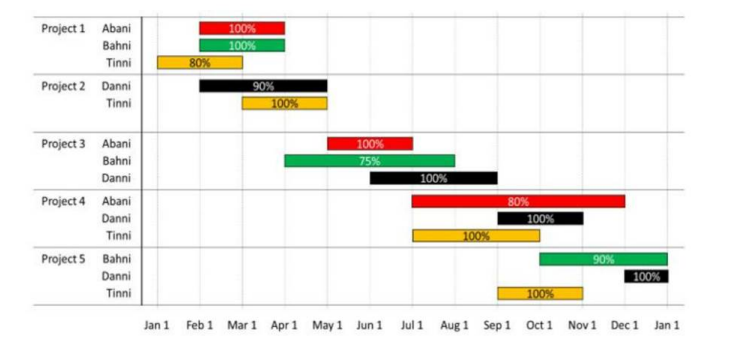
The figure above shows the schedule of four employees – Abani, Bahni, Danni and Tinni – whom Dhoni supervised in 2020. Altogether there were five projects which started and concluded in 2020 in which they were involved. For each of these projects and for each employee, the starting day was at the beginning of a month and the concluding day was the end of a month, and these are indicated by the left and right end points of the corresponding horizontal bars. The number within each bar indicates the percentage of assigned work completed by the employee for that project, as assessed by Dhoni.
For each employee, his/her total project-month (in 2020) is the sum of the number of months (s)he worked across the five project, while his/her annual completion index is the weightage average of the completion percentage assigned from the different projects, with the weights being the corresponding number of months (s)he worked in these projects. For each project, the total employee-month is the sum of the number of months four employees worked in this project, while its completion index is the weightage average of the completion percentage assigned for the employees who worked in this project, with the weights being the corresponding number of months they worked in this project.
Which of the following statements is/are true?
I: The total project-month was the same for the four employees.
II: The total employee-month was the same for the five projects.
Video Explanation

Explanatory Answer
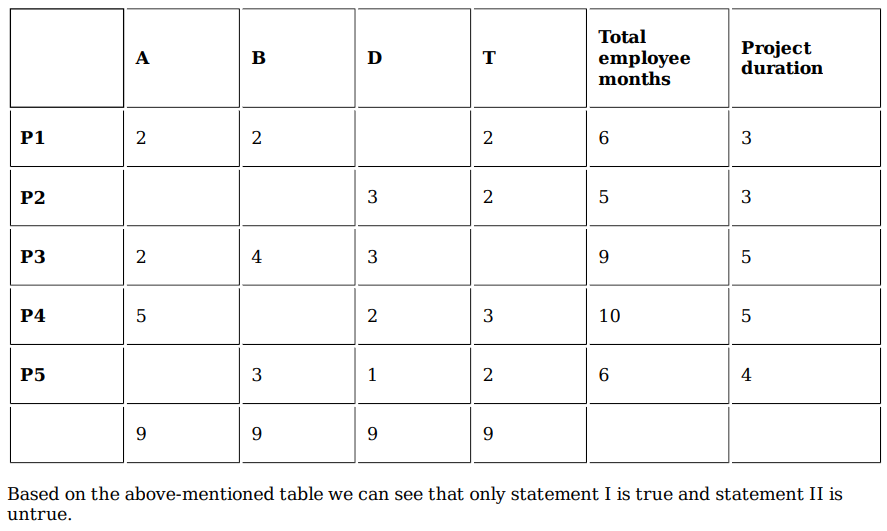
Which employees did not work in multiple projects for any of the months in 2020?
Video Explanation

Explanatory Answer
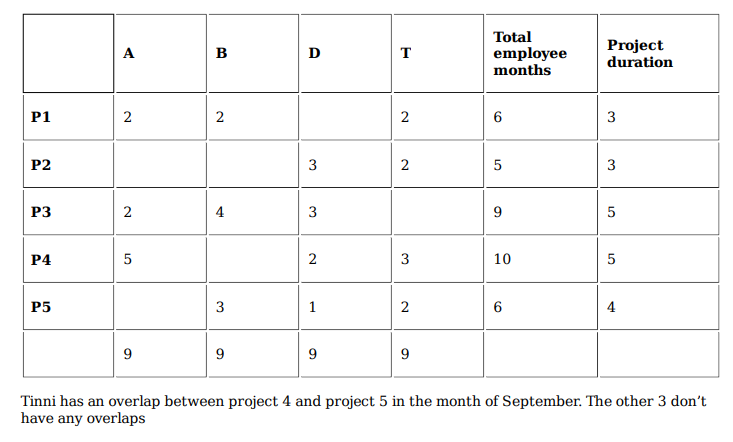
The project duration, measured in terms of the number of months, is the time during which at least one employee worked in the project. Which of the following pairs of the projects had the same duration?
Video Explanation

Explanatory Answer
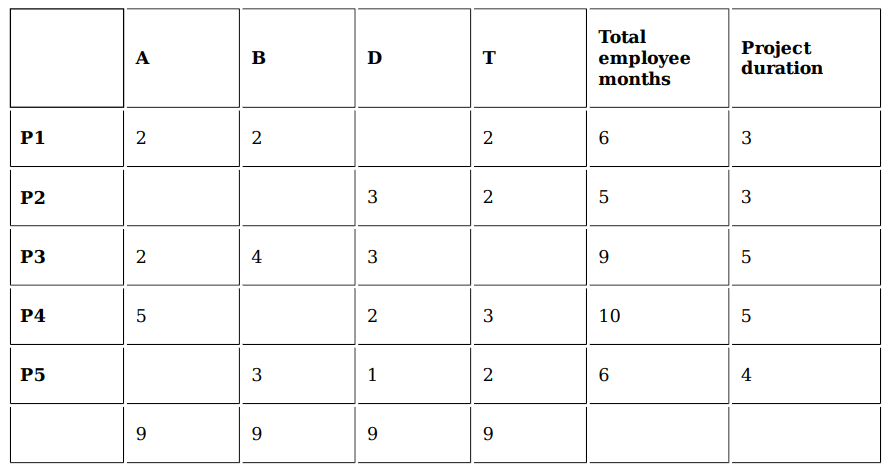
Project 1 & 2 as well as Project 3 & 4 have the same number of months but in the options we only
have Project 3 & 4.
The list of employees in decreasing order of annual completion index is:
Video Explanation

Explanatory Answer
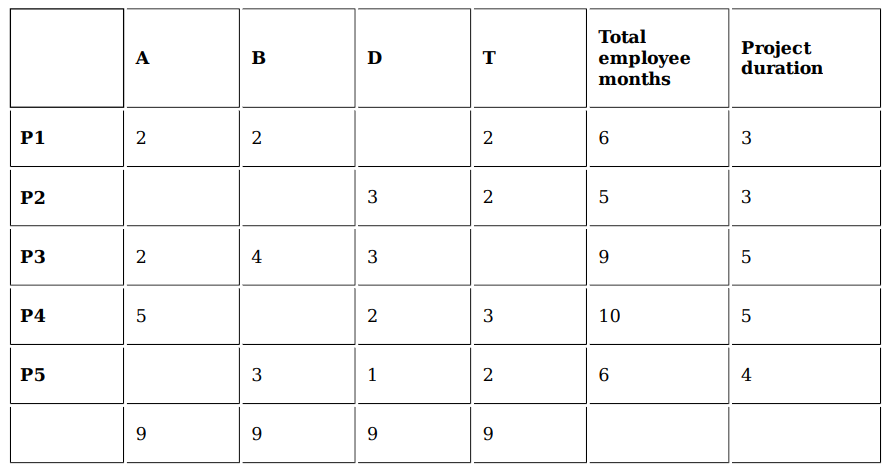
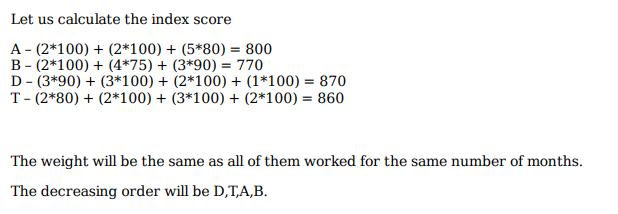
Each of the bottles mentioned in this question contains 50 ml of liquid. The liquid in any bottle can be 100% pure content (P) or can have certain amount of impurity (I). Visually it is not possible to distinguish between P and I. There is a testing device which detects impurity, as long as the percentage of impurity in the content tested is 10% or more.
For example, suppose bottle 1 contains only P, and bottle 2 contains 80% P and 20% I. If content from bottle 1 is tested, it will be found out that it contains only P. If content of bottle 2 is tested, the test will reveal that it contains some amount of I. If 10 ml of content from bottle 1 is mixed with 20 ml content from bottle 2, the test will show that the mixture has impurity, and hence we can conclude that at least one of the two bottles has I. However, if 10 ml of content from bottle 1 is mixed with 5 ml of content from bottle 2. the test will not detect any impurity in the resultant mixture.
5 ml of content from bottle A is mixed with 5 ml of content from bottle B. The resultant mixture, when tested, detects the presence of I. If it is known that bottle A contains only P, what BEST can be concluded about the volume of I in bottle B?
Video Explanation

Explanatory Answer
Now 50 ml of content in bottle A is 100% pure of which 5 ml is mixed with 5 ml from bottle B and
an impurity is detected. Now we can only detect an impurity if there is 10% or more impure
material.
Now Bottle A has 100% and we need final mixture to have 90% or less impurity which means that
Maximum % of P which bottle B can have is 80%.
This means that impurity content in bottle B is minimum 10ml and can be more than 10 too.
Thus Option A is the correct answer.
There are four bottles. Each bottle is known to contain only P or only I. They will be considered to be "collectively ready for despatch" if all of them contain only P. In minimum how many tests, is it possible to ascertain whether these four bottles are "collectively ready for despatch"?
Video Explanation

Explanatory Answer
Now either a bottle has 100% P or 0% P.
Let’s assume that 3 are 100% pure and 1 is 0% pure, so now if we mix all 4 together
Weighted average = (3*100 + 1*0)/4 = 75%
As per question if the impurity is more than 10% we will be able to detect it, thus only 1 test is
enough to determine if the bottles are ready for despatch.
There are four bottles. It is known that three of these bottles contain only P, while the remaining one contains 80% P and 20% I. What is the minimum number of tests required to definitely identify the bottle containing some amount of I?
Video Explanation

Explanatory Answer
We have 3 bottles with 100% P and 1 bottle with 20% impurity
Let’s select 2 bottles at random and mix them completely, we will end up with 2 cases
Case 1 – Both bottles test pure, then we take one of these bottles and test it with one of the two
remaining bottles. It will either come out as pure again or it will show presence of impurity.
We need 2 tests in this case.
Case 2 – We find an impurity presence in one of the bottles, again we take one of the 2 bottles
and test it with 1 of the 2 remaining bottles. It will It will either come out as pure again or it will
show presence of impurity.
We need 2 tests in this case too.
Thus we need a minimum of 2 tests to identify the bottle with the impurity.
There are four bottles. It is known that either one or two of these bottles contain(s) only P, while the remaining ones contain 85% P and 15% I. What is the minimum number of tests required to ascertain the exact number of bottles containing only P?
Video Explanation

Explanatory Answer
Answer- 1
We will take the weighted average approach here
Case 1 – 1 Bottle has 100% P and 3 bottles have 85% P
Weighted average = (1*100 + 3*85)/4 = 88.75%
Impurity will be detected
Case 2 - 2 Bottles has 100% P and 2 bottles have 85% P
Weighted average = (2*100 + 2*85)/4 = 92.5%
Impurity will not be detected
We can see that only 1 test will be enough to determine the total number of bottles with 100%
purity.









